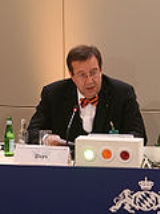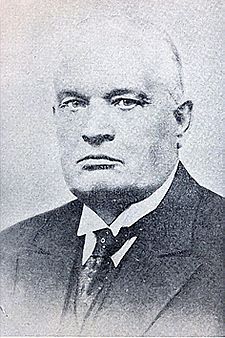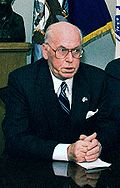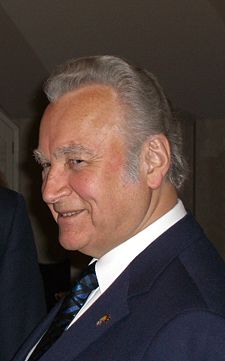
President of Estonia
Encyclopedia
The President of the Republic is the head of state
of the Republic of Estonia
.
Estonia is a parliamentary republic
, therefore President is mainly a symbolic figure and holds no executive power. The President has to suspend his membership in any political party for his term in office. Upon assuming office, the authority and duties of the President in all other elected or appointed offices terminate automatically. These measures should theoretically ensure that the President is independent and impartial in executing his authority.
The President is elected by the Riigikogu
or a special electoral body for a five-year term. The electoral body is convened in case no candidate secures a two-third-majority in Riigikogu after three rounds of balloting. The electoral body (which consists of Parliament deputies and elected representatives of all local governments) elects the president, choosing between the two candidates with the largest percentage of votes.
The President can not be elected for more than two consecutive terms.
The current President is Toomas Hendrik Ilves
elected by an electoral body on 23 September 2006 and re-elected on 29 August 2011.
. (riigivanem), who was also head of the government. However, he could not play a balancing role, should there be any conflict between the Parliament and the Government. The State Elder was completely dependent on the Parliament and could be sacked by it at any time. Estonia's constitution was amended in 1933, transforming the country from a parliamentary to a presidential state. The head of state, according to the new constitution, was also called the State Elder. However, this provision never came into effect as a result of Konstantin Päts
's coup d'état in 1934. According to the third Constitution of Estonia, the role of the head of state and also a strong executive power was vested upon the President of the Republic. Konstantin Päts became the first person to bear this title. His term was to last for six years, but ended short as Estonia was annexed by the Soviet Union
in 1940, Päts was dismissed and later arrested.
Within days after the Soviet occupation of Estonia in 1940, the President was pressured into affirming the Andrei Zhdanov
appointed puppet government of Johannes Vares
, following the arrival of demonstrators accompanied by Red Army troops with armored vehicles to the Presidential palace. Following the sham elections in July, Päts was dismissed from office and Vares assumes presidential responsibilities. Later in July Päts, along with his son, daughter-in-law and two grandsons, was deported to Ufa
in Russia.
According to the 1938 constitution, should the position of the President of the republic become vacant or otherwise incapacitated, the president duties are assumed by the Prime Minister. However, during times of war or incapacitation lasting longer than six months, the constitution provides for the election of an acting President by the Electoral Council. The Electoral Council met in secret on April 20, 1944, and determined that the appointment of Vares as Prime Minister in 1940 was unlawful according to the 1938 constitution. The Council elected Jüri Uluots
as acting President of Estonia on April 21st. Uluots appointed Otto Tief
as Prime Minister. Tief was subsequently arrested by the re-occupying Soviet forces in September.
In September of 1944, Uluots and the surviving members of the Tief government escaped to Sweden. The day before Uluots died in January, 1945, a successor August Rei
was named to assume the position of acting President. Following Rei's death in 1963, the role passed to Aleksander Warma
, then to Tõnis Kint
in 1971, then to Heinrich Mark
in 1990. Then in 1992 the last acting President of Estonia, Heinrich Mark, handed over his credentials to the newly elected President of the restored republic, Lennart Meri
.
After Estonia regained independence, a parliamentary constitution based upon the 1938 law was adopted again. Four elections have taken place (in 1992, 1996, 2001 and 2006), in all of which the parliament failed to choose the President and the election passed to the electoral assembly. Lennart Meri
was elected in 1992 (this election, unlike later ones, had a public round) and re-elected in 1996, defeating Arnold Rüütel
both times. Rüütel himself became the next President in 2001. In 2006, Toomas Hendrik Ilves
won the election.
Head of State
A head of state is the individual that serves as the chief public representative of a monarchy, republic, federation, commonwealth or other kind of state. His or her role generally includes legitimizing the state and exercising the political powers, functions, and duties granted to the head of...
of the Republic of Estonia
Estonia
Estonia , officially the Republic of Estonia , is a state in the Baltic region of Northern Europe. It is bordered to the north by the Gulf of Finland, to the west by the Baltic Sea, to the south by Latvia , and to the east by Lake Peipsi and the Russian Federation . Across the Baltic Sea lies...
.
Estonia is a parliamentary republic
Parliamentary republic
A parliamentary republic or parliamentary constitutional republic is a type of republic which operates under a parliamentary system of government - meaning a system with no clear-cut separation of powers between the executive and legislative branches. There are a number of variations of...
, therefore President is mainly a symbolic figure and holds no executive power. The President has to suspend his membership in any political party for his term in office. Upon assuming office, the authority and duties of the President in all other elected or appointed offices terminate automatically. These measures should theoretically ensure that the President is independent and impartial in executing his authority.
The President is elected by the Riigikogu
Riigikogu
The Riigikogu is the unicameral parliament of Estonia. All important state-related questions pass through the Riigikogu...
or a special electoral body for a five-year term. The electoral body is convened in case no candidate secures a two-third-majority in Riigikogu after three rounds of balloting. The electoral body (which consists of Parliament deputies and elected representatives of all local governments) elects the president, choosing between the two candidates with the largest percentage of votes.
The President can not be elected for more than two consecutive terms.
The current President is Toomas Hendrik Ilves
Toomas Hendrik Ilves
Toomas Hendrik Ilves is the fourth and current President of Estonia. He is a former diplomat and journalist, was the leader of the Social Democratic Party in the 1990s and later a member of the European Parliament...
elected by an electoral body on 23 September 2006 and re-elected on 29 August 2011.
History
Estonia didn't have a president from 1918 to 1938. This institution was intentionally left out of the first Estonian constitution, for its authors tried to avoid the concentration of power in one person's hands by all means possible. This eventually led to a creation of an ultra-parliamentary system. The power of the Parliament was practically unlimited and the Government was totally controlled by the Parliament. The functions that are usually vested on a president in parliamentary systems were divided among the speaker of Riigikogu, the State Elder and the Government. Until 1934, the nominal head of state was the State ElderState Elder of Estonia
The Head of State of Estonia was the official title of the Estonian head of state and head of government from 1920 to 1937...
. (riigivanem), who was also head of the government. However, he could not play a balancing role, should there be any conflict between the Parliament and the Government. The State Elder was completely dependent on the Parliament and could be sacked by it at any time. Estonia's constitution was amended in 1933, transforming the country from a parliamentary to a presidential state. The head of state, according to the new constitution, was also called the State Elder. However, this provision never came into effect as a result of Konstantin Päts
Konstantin Päts
Konstantin Päts VR I/1 and III/1 was the most influential politician of interwar Estonia. He was one of the first Estonians to become active in politics and started an almost 40-year political rivalry with Jaan Tõnisson, first through journalism with his newspaper Teataja, later through politics...
's coup d'état in 1934. According to the third Constitution of Estonia, the role of the head of state and also a strong executive power was vested upon the President of the Republic. Konstantin Päts became the first person to bear this title. His term was to last for six years, but ended short as Estonia was annexed by the Soviet Union
Soviet Union
The Soviet Union , officially the Union of Soviet Socialist Republics , was a constitutionally socialist state that existed in Eurasia between 1922 and 1991....
in 1940, Päts was dismissed and later arrested.
Within days after the Soviet occupation of Estonia in 1940, the President was pressured into affirming the Andrei Zhdanov
Andrei Zhdanov
Andrei Alexandrovich Zhdanov was a Soviet politician.-Life:Zhdanov enlisted with the Russian Social Democratic Labour Party in 1915 and was promoted through the party ranks, becoming the All-Union Communist Party manager in Leningrad after the assassination of Sergei Kirov in 1934...
appointed puppet government of Johannes Vares
Johannes Vares
Johannes Vares , commonly known as Johannes Vares Barbarus, was an Estonian poet, doctor, and politician.Vares was born in Heimtali, now in Pärsti Parish, Viljandi County, and educated at Pärnu Gymnasium...
, following the arrival of demonstrators accompanied by Red Army troops with armored vehicles to the Presidential palace. Following the sham elections in July, Päts was dismissed from office and Vares assumes presidential responsibilities. Later in July Päts, along with his son, daughter-in-law and two grandsons, was deported to Ufa
Ufa
-Demographics:Nationally, dominated by Russian , Bashkirs and Tatars . In addition, numerous are Ukrainians , Chuvash , Mari , Belarusians , Mordovians , Armenian , Germans , Jews , Azeris .-Government and administration:Local...
in Russia.
According to the 1938 constitution, should the position of the President of the republic become vacant or otherwise incapacitated, the president duties are assumed by the Prime Minister. However, during times of war or incapacitation lasting longer than six months, the constitution provides for the election of an acting President by the Electoral Council. The Electoral Council met in secret on April 20, 1944, and determined that the appointment of Vares as Prime Minister in 1940 was unlawful according to the 1938 constitution. The Council elected Jüri Uluots
Jüri Uluots
Jüri Uluots was an Estonian prime minister, journalist, prominent attorney and distinguished Professor and Dean of the Faculty of Law at the University of Tartu....
as acting President of Estonia on April 21st. Uluots appointed Otto Tief
Otto Tief
Otto Tief was a lawyer, an Estonian military commander during the Estonian War of Independence and a politician. He was Acting Prime Minister of the last government of Estonia before Soviet troops occupied Estonia in 1944...
as Prime Minister. Tief was subsequently arrested by the re-occupying Soviet forces in September.
In September of 1944, Uluots and the surviving members of the Tief government escaped to Sweden. The day before Uluots died in January, 1945, a successor August Rei
August Rei
August Rei VR III/1 was an Estonian Social Democratic politician. He was born in Pilistvere, Kõo Parish, Viljandi County.- Education :...
was named to assume the position of acting President. Following Rei's death in 1963, the role passed to Aleksander Warma
Aleksander Warma
Aleksander Warma VR I/3 was an Estonian navy officer, diplomat and painter....
, then to Tõnis Kint
Tõnis Kint
Tõnis Kint was an Estonian politician. He served as "Prime Minister in duties of the President" from December 23, 1970 to March 1, 1990.From April 7, 1938 member of the Chamber of Deputies...
in 1971, then to Heinrich Mark
Heinrich Mark
Heinrich Mark was born on October 1, 1911, in Krootuse, Kõlleste Parish, now in Põlva County, Estonia. He died on August 2, 2004, in Stockholm, Sweden....
in 1990. Then in 1992 the last acting President of Estonia, Heinrich Mark, handed over his credentials to the newly elected President of the restored republic, Lennart Meri
Lennart Meri
Lennart Georg Meri was a writer, film director and statesman who served as the second President of Estonia from 1992 to 2001. Meri was a leader of the Estonian independence movement.-Early life:...
.
After Estonia regained independence, a parliamentary constitution based upon the 1938 law was adopted again. Four elections have taken place (in 1992, 1996, 2001 and 2006), in all of which the parliament failed to choose the President and the election passed to the electoral assembly. Lennart Meri
Lennart Meri
Lennart Georg Meri was a writer, film director and statesman who served as the second President of Estonia from 1992 to 2001. Meri was a leader of the Estonian independence movement.-Early life:...
was elected in 1992 (this election, unlike later ones, had a public round) and re-elected in 1996, defeating Arnold Rüütel
Arnold Rüütel
Arnold Rüütel OIH was the third President of the Republic of Estonia from October 8, 2001 to October 9, 2006. He was the second President since Estonia regained its independence in 1991....
both times. Rüütel himself became the next President in 2001. In 2006, Toomas Hendrik Ilves
Toomas Hendrik Ilves
Toomas Hendrik Ilves is the fourth and current President of Estonia. He is a former diplomat and journalist, was the leader of the Social Democratic Party in the 1990s and later a member of the European Parliament...
won the election.
Duties of the President according to Estonian Constitution
The President of the Republic of Estonia:- acts as the highest representative of the Republic in international affairs (this task includes signing the international treaties preliminarily approved by the Government);
- appoints and recalls, on the proposal of the Government, the diplomatic representatives of the Republic of Estonia to foreign states and international organizations; receives the credentials of the diplomatic agents accredited to Estonia;
- declares regular elections of the RiigikoguRiigikoguThe Riigikogu is the unicameral parliament of Estonia. All important state-related questions pass through the Riigikogu...
(the Parliament of Estonia) and, pursuant to respective provisions of the Constitution, its extraordinary elections. Extraordinary elections can be declared by the President at four occasions: if the Parliament turns out to be unable to pass the State Budget Act; if the Parliament fails to obtain the nation's approval on a referendum; if the Parliament fails to elect the Prime Minister after it receives the opportunity (at those occasions announcing extraordinary elections is obligatory and the President simply acts as the "highest notary" of the state); or if the Parliament passes a censure motion against the Government, and the Government, in its turn, requests the President to consider announcing extraordinary elections (in this case the President may, however, say "no", if he founds organizing extraordinary elections unnecessary or unreasonable for whatever reason);
- convenes the new membership of the RiigikoguRiigikoguThe Riigikogu is the unicameral parliament of Estonia. All important state-related questions pass through the Riigikogu...
and opens its first session;
- proposes to the Chairman of the Riigikogu to convene an extraordinary session of the Riigikogu in case of necessity;
- promulgates laws and signs the instruments of ratification. The President may refuse to promulgate a bill into law within 14 days after its receipt if he or she finds it contrary to the Constitution of EstoniaConstitution of EstoniaThe Constitution of Estonia is the fundamental law of the Republic of Estonia and establishes the state order as that of a democratic republic where the supreme power is vested in its citizens. It was adopted in a freely elected Estonian Constituent Assembly on 15 June 1920 and came into force on...
or unacceptable for some political reasons. In this case the President returns the bill to Riigikogu with a motivation of his decision. When that happens, RiigikoguRiigikoguThe Riigikogu is the unicameral parliament of Estonia. All important state-related questions pass through the Riigikogu...
may reconsider and amend the bill according to remarks of the President, drop the matter, or pass the bill without any changes for a second time. When Riigikogu takes the third option, the President may not simply refuse to sign the bill into law anymore, but is obliged to promulgate it or, if he or she still believes it to be unconstitutional, to ask Riigikohus (the Supreme Court) to rule on its constitutionality. If Riigikohus finds no violation of constitution, the President must sign the bill into law.
- may initiate amendment of the Constitution. Until now this right has been used at two occasions only. President Lennart MeriLennart MeriLennart Georg Meri was a writer, film director and statesman who served as the second President of Estonia from 1992 to 2001. Meri was a leader of the Estonian independence movement.-Early life:...
proposed to introduce direct elections of the President and to found a Constitutional Court on the last day of his stay in office. This proposal did not find support within the walls of the Parliament. The Republic's current President Toomas-Hendrik Ilves proposed to remove mentioning the institution of the Commander and the Commander-in-Chief of the Defense Forces from the Constitution, so that he or she could be appointed by the Government, and not by Riigikogu. The respective amendment was finally approved by Riigikogu on 13 April 2011 and entered into force on 22 July 2011 ;
- after appropriate consultations with the parliamentary fractions nominates the candidate for the post of the Prime Minister (who is normally the leader of the parliamentary coalition or the largest party in Riigikogu), who has to go through an approval vote in the parliament. If the candidate, nominated by the President, fails to obtain the parliamentary approval or finds himself to be incapable of forming the Government, the President may nominate another candidate. If the second candidate also fails to obtain the approval of the Parliament or if the President refuses to nominate the second candidate, the right to nominate the Prime-Minister is transferred to Riigikogu;
- on the proposal of the Prime-Minister formally appoints to office and dismisses members of the Government, whereas the Prime-Minister's proposal is binding for the President. The President may not refuse to appoint or dismiss a minister, should the Prime-Minister make a respective proposal. So the President's role is virtually limited to a formal signing of the respective documents;
- nominates the Chairman of the Supreme Court, the Chairman of the Board of the Bank of Estonia, the Auditor Genera and the Chancellor of Justice. The President may, theoretically, nominate any candidate at his or her discretion. However, the traditions of a parliamentary republic suppose that the President organizes respective consultations with the parliamentary fractions and proposes only such a candidate that will be able to secure the support of Riigikogu, for all of those officers must pass through an approval vote in the parliament before they can assume their office;
- on the proposal of the Board of the Bank of Estonia, appoints to office the President of the Bank of Estonia. The President may, however, refuse to accept the proposal and demand for another candidate to be proposed (theoretically for an unlimited number of times). This option was previously exercised by President Lennart Meri.
- on the proposal of the Supreme Court, appoints judges (it's also important to mention that judges appointed by the President may be taken to legal responsibility only with the President's consent);
- confers state decorations, military and diplomatic ranks;
- is the Supreme Commander of the National Defense Forces of Estonia (in reality, this function is usually considered largely ceremonial and symbolic);
- makes proposals to the Riigikogu to declare martial law, to order mobilization and demobilization and to declare a state of emergency;
- declares martial law in case of attack on Estonia, orders mobilization, and appoints the Commander-in-Chief of the Defense Forces (in this case the President does not have to wait for the Parliament's decision and appoints the Commander-in-Chief at his own discretion);
- by way of clemency, releases or grants commutation to convicted offenders at their request;
- initiates the bringing of criminal charges against the Legal Chancellor.
1938–1940
| No. | Image | Name | Date of birth/death | Took office | Left office | Affiliation/Notes |
|---|---|---|---|---|---|---|
| 1 |  |
Konstantin Päts Konstantin Päts Konstantin Päts VR I/1 and III/1 was the most influential politician of interwar Estonia. He was one of the first Estonians to become active in politics and started an almost 40-year political rivalry with Jaan Tõnisson, first through journalism with his newspaper Teataja, later through politics... |
23 February 1874 – 18 January 1956 |
24 April 1938 | 23 July 1940 | Isamaaliit |
1992–present
| No. | Image | Name | Date of birth/death | Took office | Left office | Affiliation/Notes |
|---|---|---|---|---|---|---|
| 2 |  |
Lennart Meri Lennart Meri Lennart Georg Meri was a writer, film director and statesman who served as the second President of Estonia from 1992 to 2001. Meri was a leader of the Estonian independence movement.-Early life:... |
29 March 1929 – 14 March 2006 |
6 October 1992 | 8 October 2001 | Pro Patria |
| 3 |  |
Arnold Rüütel Arnold Rüütel Arnold Rüütel OIH was the third President of the Republic of Estonia from October 8, 2001 to October 9, 2006. He was the second President since Estonia regained its independence in 1991.... |
10 May 1928 | 8 October 2001 | 9 October 2006 | People's Union of Estonia People's Union of Estonia The People's Union of Estonia is a political party in Estonia, currently led by Margo Miljand.In the 2003 parliamentary election, the party collected 64,463 votes, which made 13.0% share of all votes and 13 mandates out of 101. In 2007's election, this dropped to 39,211 votes , and six seats in... |
| 4 |  |
Toomas Hendrik Ilves Toomas Hendrik Ilves Toomas Hendrik Ilves is the fourth and current President of Estonia. He is a former diplomat and journalist, was the leader of the Social Democratic Party in the 1990s and later a member of the European Parliament... |
26 December 1953 | 9 October 2006 | Incumbent | Social Democratic Party Social Democratic Party (Estonia) The Social Democratic Party is a social-democratic party in Estonia, led by Sven Mikser. It has been a member of the Party of European Socialists since 16 May 2003 and a member of the Socialist International since November 1990.... |

